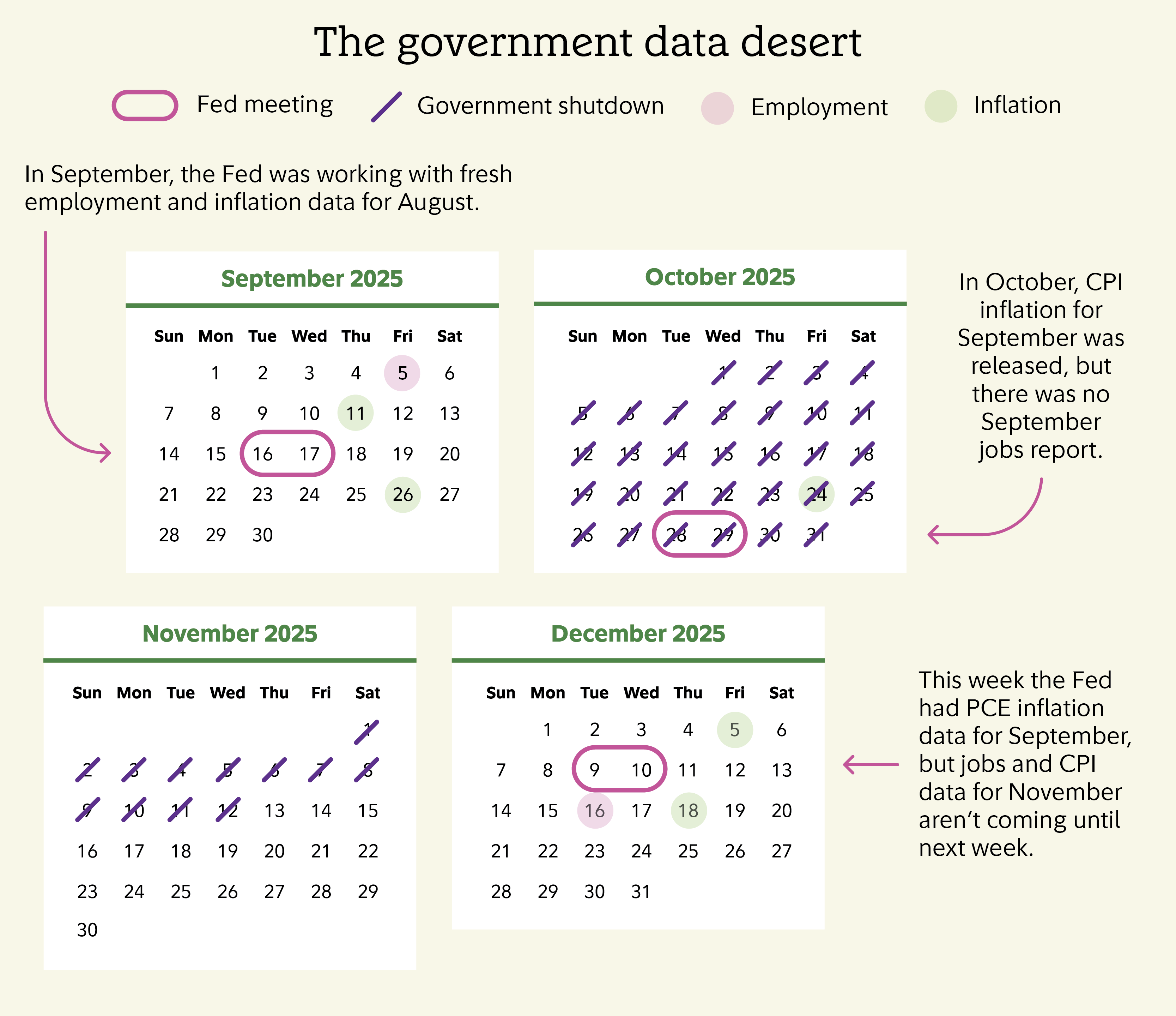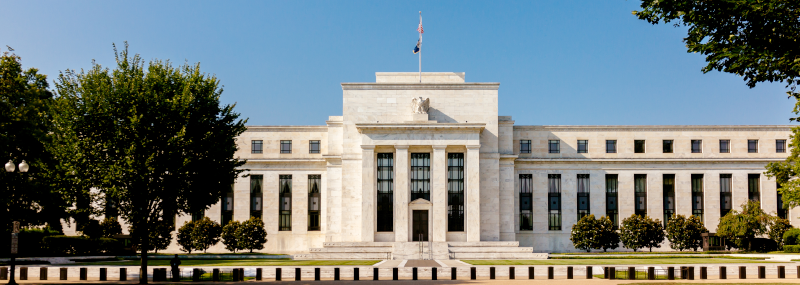The Fed cut rates again at its December meeting, but signaled to investors that there’s no guarantee more rate cuts will be coming in the near future.
The central bank cut its benchmark federal funds rate by another quarter of a percentage point, bringing it to a range of 3.50%–3.75%.
While Fed Chair Jerome Powell was able to rally enough Federal Open Market Committee (FOMC) members to vote in favor of this final cut for 2025, it’s become clear that there may not be broad enough support for additional cuts in the near term—unless new data were to show the job market has weakened further.
Why the Fed cut despite the lack of official data
Reporting on the key official government data sources that the Fed relies on largely stopped amid the government shutdown in October. Although agencies like the Bureau of Labor Statistics have resumed data collection, fresh official figures on inflation and jobs haven’t yet been published.

This means the most recent official government data the Fed had on hand as it made this decision was from September. “The committee has been in a data void, and the data they do have is rather stale,” says Kana Norimoto, macro strategist on Fidelity’s fixed income research team.
Still, evidence from other sources—including private data on the job market released by payroll-processing companies and anecdotal reports of company layoffs—pointed to continued weakness in the job market. That evidence helped to justify the additional cut, says Andrew Garvey, the lead monetary policy analyst on Fidelity’s Asset Allocation Research Team.
“This was an insurance cut,” says Garvey. “The Fed cut to try to ensure that weakness in the labor market doesn’t get any worse,” he says.
Why this might be the last cut
However, the weakness in the job market thus far has looked like it might simply be a temporary soft patch rather than the start of a precipitous decline.
Layoffs have been occurring at the margins rather than in a widespread manner. Plus, reported job numbers are inherently backward looking, reflecting what has already happened rather than what may happen in the future. More forward-looking considerations—such as the strong outlook for corporate earnings growth and heavy corporate investment spending—suggest an economy that may be strengthening, not weakening. (Read more about the outlook for the economy in 2026.)
Investors and the Fed will get some clarity in less than a week, when the November jobs data and unemployment rate are released on December 16. “If that shows unemployment has risen above 4.5%, which FOMC members had forecasted as the upper end of the measure of slack in this cycle, then a January cut could be back on the table,” says Norimoto.
On the other hand, if it shows the unemployment rate has improved since September, when it was 4.4%, “then maybe this is it in terms of rate cuts,” says Garvey.
Approaching neutral
This cut marks the third reduction this year and means the fed funds rate has now come down by a total of 1.75 percentage points since it peaked in 2023–2024. At its peak, the rate was “restrictive”—i.e., high enough to have a decelerating effect on the economy.
The Fed has been gradually cutting in an effort to bring interest rates down to a more “neutral” level—meaning a level at which they neither decelerate nor accelerate the economy.
Economists, and even individual Fed members, disagree on exactly where that “neutral” level of interest rates is. But there is reasonably broad agreement that with this cut, the fed funds rate is roughly in or close to neutral territory, says Norimoto.
In other words, unless new economic data were to shift the goal posts, the Fed may have already reached the endpoint it had loosely set for itself in this rate-cutting cycle.
Competing views, and a looming change in leadership
One more factor complicating the outlook for Fed policy in 2026 is that in recent months the institution’s individual members have begun to appear less unified in their views.
This was the fourth FOMC decision in a row that faced at least one formal dissent from a committee member (there were 3 dissents from this decision—with 1 member who wanted to cut rates by a greater amount and 2 who preferred to hold rates steady). Minutes from the Fed’s previous meeting described committee members having “strongly differing views” on the appropriate near-term decisions on interest rates.
Norimoto says that this open acknowledgement of different camps within the Fed marks a significant change for an institution that has tended to make consensus decisions—particularly under Chair Powell. And with a wider dispersion of views, it’s becoming harder to anticipate how the Fed may react to incoming data.
“It’s a new reaction function that the market’s trying to understand,” Norimoto says, referring to how the Fed interprets and responds to signals in economic data.
That sense of transition may not resolve anytime soon. A Board of Governors seat opens at the end of January, and many Fed watchers expect President Trump to use it to install his choice for Fed chair ahead of Powell’s term ending in May.
“2026 may be a year of 2 halves,” says Norimoto. “Powell's approach will guide policy until May, after which a Trump-appointed chair could usher in a very different policy framework."
Where does the Fed think the economy is going?
The Fed released updated economic projections at this meeting, including an update to its closely watched dot plot.
Those projections show that FOMC members are now expecting higher economic growth and lower inflation in 2026, than they were a few months ago.
However, given the data vacuum, investors may put less weight on these projections than they normally would.
What rate cuts may mean for consumers and investors
It’s important to understand that the Fed only controls very short-term interest rates. The Fed does not set interest rates on mortgages, CDs, or bonds, though its actions influence these rates.
The impact for consumers may be most immediately felt with lower interest payments on debt with rates tied to the prime rate, such as some credit cards, adjustable-rate mortgages, and home equity lines of credit. Savers and investors may notice the impact most directly with lower interest rates on very short-term fixed income, like money market funds and short-term Treasurys and CDs.



